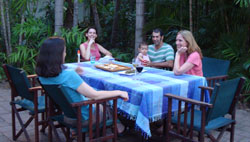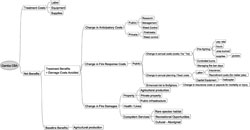University of Maryland Center for Environmental Science
Strategic Management of the Risks Posed by Grassy Weeds in Northern Australia
Charles Darwin University, Northern Territory, Austraila
Managing invasive species can be costly, but ignoring them can also be costly. This project aims to compare the economic benefits of management of two non-native grassy invasive species with costs of control to inform management decisions. In collaboration with researchers at Charles Darwin University and government agencies, we are evaluating net economic effects for two species that are creating problems within pasture and natural lands of Northern Australia. Impacts stem from enhanced fire intensity, reduced native species habitat, and altered hydrology (Rossiter et al. 2004, Douglas and O'Connor 2004).
Gamba grass (Adropogon Gayanus), was introduced to improve rangeland productivity in Northern Australia. Under certain conditions, the grass can increase cattle liveweight gain and thereby provide private benefits to ranchers. However, the spread of gamba outside of well-managed pastures has resulted in negative environmental, economic and socio-cultural impacts. Public agencies are called upon to control its spread and to fight intense gamba-fueled fires, in order to protect human life, property and infrastructure.
Para grass (Urochloa mutica), was also introduced to improve pasture productivity but it now invades wetlands and reduces the extent and diversity of habitats for waterbirds and other wetland species.
Economic Analysis Components
- Dynamic cost model quantifying site, location, and treatment effects on cost
- Absolute benefits assessment ($) for CBA that establishes changes in fire-fighting costs and property damages with and without treatment
- Relative benefit assessment (index or $) for CEA that adds changes in ecosystem service benefits
Rossiter, N.A. Setterfield, S.A., Douglas, M.M., Hutley, L.B. and Cook, G. 2004. Exotic grass invasion in the tropical savannas of northern Australia: Ecosystem consequences. In: Sindel, B.M. and Johnson, S.B. (eds). Proceedings of the 14th Australian Weeds Conference. Wagga Wagga, Sept. 6-9. Weed Society of New South Wales, Sydney. pp. 168-171.
Douglas, M.M. and O'Connor, R.A. (2004) Weed invasion changes fuel characteristics: Para grass (Urochloa mutica (Forssk.) T.Q. Nguyen) on a tropical floodplain. Ecological Management and Restoration 5: 147-48

